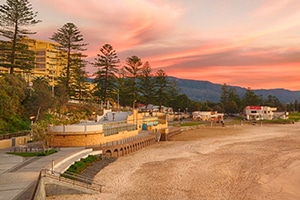Please fill out the details below to receive information on Blue Wealth Events
"*" indicates required fields

“Satellite cities” are those urban activity centres that lay on the fringes of our capitals and operate through their own semi-independent economies. Melbourne has Geelong, Brisbane has Moreton Bay and Sydney has two in Newcastle and Wollongong. Often, the capital city property markets grow and the surrounding satellite markets leverage off this to create their own growth. As Sydney grew at unprecedented levels, we saw its neighbouring coastal cities in Newcastle and Wollongong replicate similarly strong performance. Demand for these cities is largely driven by their relative affordability and desirability of lifestyle.
Over the last three years, Newcastle and Wollongong have experienced price growth of 15.4% to $739,000, and 22% to $595,000 respectively. Property demand in the surrounding markets grew strongly in reaction to their proximity to Sydney. Resident demand was largely driven by the ease of connection to Sydney employment, with access to the appealing coastal lifestyle. As Sydney’s median house price rocketed out of reach of many home buyer since 2012, many opted to push for a sea change and the option of a longer commute which aided in driving property prices. Ultimately, the demand to get away from Sydney’s expensive and rapidly expanding urban sprawl, transferred to positive price growth in outside markets.
With Sydney now hitting a period of stagnation, many are left asking where to now for the New South Wales coastal satellite cities? This topic has attracted commentary from a number of Australia’s largest economic units. These coastal centres now support over 750,000 Australian residents (larger than the population of Tasmania) and an impending collapse could be detrimental to the NSW economy.
Wollongong
Stagnation from the Sydney market is expected to flow onto Wollongong. Prices are expected to remain level, with the possibility of 2% growth over the coming 3 years to 2021. Real property values failed to rise to levels that were as inflated as those in Sydney, which expected to save the market from major price falls, however high levels of oncoming supply will likely dampen the market over the next 2 years.
Newcastle
Newcastle has grown into a major logistics hub, with the market becoming less dependent on Sydney’s economic growth. Improving employment conditions are likely to protect the region from major price falls over the coming 3 years. The addition of major infrastructure projects such as the University of Newcastle Honeysuckle campus will also provide a push for first hand employment growth, aiding the region to remain relatively stable. Price growth to 2021 will remain stunted and subdued, with annual growth levels forecast to be in line with inflation at no higher than 2%.
Sydney’s housing slowdown will impact the growth of these markets for years to come. The price correction should be relatively moderate and growth will be in line with the inflationary rate if anything. Both satellite cities are yet to be approved by our model, that is not to say that the opportunity for these markets are in the future, but at present stronger opportunities lay elsewhere.
